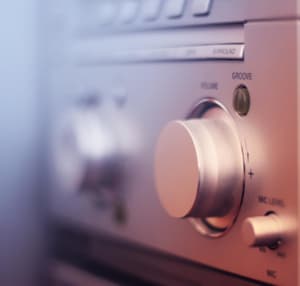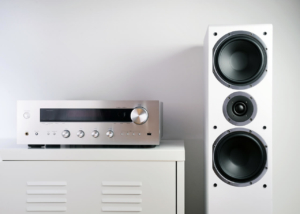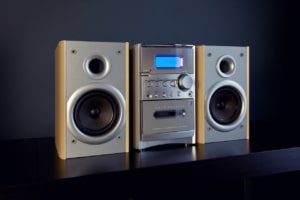Best selling stereos
What is a stereo?
With a stereo system – too HiFi-System or simply music system - is a device or assembly of devices used in the field of consumer electronics for the reproduction of sound.
A stereo system combines different devices, in the case of the compact system in one housing, in the case of component systems by connecting the individual components.
Typically, a stereo consists primarily of one amplifier and speakers and various connectors or devices for reproducing sound. These include, for example, this Radio, CD player, the turntable, the cassette recorder or just a USBConnection, a Bluetooth interface.
While the forerunners of stereo systems such as music chests or device combinations that have a turntable and a Radio contained, had been in circulation since the 1950s, the stereo system as we know it today only came into use in the mid-1960s.
The so-called compact systems were particularly popular at the beginning of the 70s. At that time, the hi-fi systems usually consisted of one Radio and a turntable. This determined this form of the system, because the round, rotating record required a certain space.
Consequently, stereo systems were produced in a cube-like design. The turntable was always on top as the top component and was fitted with a plastic hood for protection.
This type of stereo was the most common model until the 1980s. But in the 1980s, component hi-fi systems came into vogue. Both the compact systems and especially the stereo systems based on the building block principle were relatively large until the late 1980s, so that they almost took up the space of an entire piece of furniture.

Since the 1990s, the turntable has been increasingly replaced by the cassette deck and the CD player replaced. Eventually, stereo systems were also made without a turntable. This had an interesting side effect: the compact system test shows that the systems no longer had to be so large from that point on.
Previously, the dimensions of the stereo system were limited by the size of the record player, after which there was a little more freedom in the design. However, you can read in numerous articles in well-known newspapers that turntables are on the rise again as part of the retro development.
Accordingly, the size of compact systems could change again in the future.
Since the 2000s, a new development can contribute to a further change in the compact system: digital storage media such as USB sticks or streaming services.
As can be clearly seen in the compact system test, the connections and interfaces are therefore of greater importance today.
How does a stereo system work?
Depending on whether you have a stereo system based on the building block principle or a compact system, the different the connection and commissioning of the device can be. A brick stereo system is a little more complicated to hook up, as these systems are made up of different components.
These components must be wired together. However, the music system test shows that modern amplifiers usually have labeled connections that make it easier to connect by showing which cable should be plugged in where.
Some amplifiers also have power sockets into which the individual audio devices can be plugged. If none of these sockets are on the stereo system itself, you can also plug the plugs directly into the socket in the wall or into a multiple socket.
With a compact system, on the other hand, this is the only step you have to take to prepare, a compact system test emphasizes.
Afterwards, as soon as the system - regardless of whether it is a compact system or a component system - is connected to the power grid, the system can be switched on. The function can usually be selected on the amplifier: Radio, CD etc. Now only need to adjust the volume and the Klang can be set.
What should I look out for when buying a stereo system?
Before you select and buy the right device from a hi-fi system test, you should check your hi-fi system for certain aspects before you buy it. We have selected for you the most important points that you should consider when you have decided to buy a stereo system.
Internal audio devices and connection options for external devices
What audio equipment do you need? Which audio devices are included in the compact system or - in the case of a component system - which audio devices can be connected?
If you are clear about which audio devices you will use, you can usually use a comparison table in a micro stereo system test or in a compact system test from 2017 to see which system provides you with the right connections and components.
Wireless Connections
Even if you still think that you don't need wireless connections today, you should also think about future devices that you may buy in the future.
In a hi-fi system test or in a micro stereo system test, make sure that the system definitely has a Bluetooth interface. Some music systems now offer NFC connections, which makes sense if your smartphone or tablet has this type of connection.
Remote Control
As obvious as it may seem these days, a remote control is not automatically included in the scope of delivery. So if you like it comfortable, before you buy your hi-fi system, you should do a test using a comparison table to see which of the stereo systems also includes a remote control.
Loudspeakers
If you like it loud or are particularly demanding when it comes to sound, the quality of the Loudspeakers probably particularly important. A first indication that points to good sound is that the Loudspeakers are not installed internally in the system.
This is because the boxes can be set up at certain angles in the apartment. This is the basic requirement for optimal sound, explains a hi-fi system test.
Klang
The systems can differ significantly in terms of sound, as can be read in a compact system test. As a rule, the stereo systems based on the building block principle have the edge in this regard. However, this also has to do with the fact that the boxes and devices of your choice can be connected here.
That means you are completely free in your sound design. If you decide on a mini stereo system, read a compact system test to see which system is a good choice in terms of sound.
CD player
In times of digital storage formats, you should definitely make sure that your system - if you want to buy a compact system - also has a CD player that also has MP3 and WAV can play.
In a stereo system test from Chip or other providers, you can read which hi-fi systems do well in this aspect. Also make sure that the letter combinations CD+R, CD-R, CD+RW or CD-RW can be found on the player.
Radio
The Radio makes the difference today. Even if it can be read in a compact system test from 2017 that the analog Radio should not be abolished in the next few years, it is worth investing in DAB + technology now.
After all, one also hopes that the newly purchased system will last for several years. And who knows what until then with the analog Radio happens.
What's in the box
Nowadays you can find a lot of things in hi-fi systems that you don't necessarily need, but which make the system easy to use. Look up a summary table from a Chip or other vendor's stereo system review to see what's included.
Stereo FAQ
Which stereo is the best?
In a stereo system test and in a micro stereo system test you can see which hi-fi system is the best. You should only make sure that it is an independent trustworthy stereo system test. Experts recommend the Chip stereo system test, for example.
Which stereo system suits me?
A compact system test from 2017 gives a good answer to the question of which hi-fi system suits me. In a hi-fi system test, you should read through the criteria that you should consider before you buy your system. For each of the criteria, ask yourself to what extent it is interesting for you personally,
What types of stereo systems are there?
Stereo systems can be distinguished in relation to two essential points. The one aspect that is important in a stereo test concerns the radio reception of the stereo. Nowadays, radio reception is becoming more and more important in a hi-fi system, so the industry has also invested in the development of new technologies here, with the focus on the digitization of radio.
With radio reception nowadays, a DAB stereo system can be replaced by a FM distinguish stereo. The other aspect by which stereo systems can be distinguished in a hifi system test is the design of the stereo system.

In this way, stereo systems based on the building block principle can be differentiated from a compact system or a mini stereo system. In the following we want to take a closer look at the different types of stereo systems.
Stereo systems with different radio reception
As already explained in a mini stereo test, different types of stereo systems can be identified in terms of their radio reception. The differentiating feature here is analogue vs. digital. Both types of radio reception have advantages and disadvantages.
Stereo system with analog radio in the test
As can be read in a compact system test, the analog reception is the analog VHF reception that has been established for decades. However, it has now become much more modern than it was back then.
This is the so-called Radio Data System (RDS), but also due to the automatic station search, which makes the tedious task of searching for stations much more pleasant. Nevertheless, it can still be stated that there is often noise in the analog Radio gives.
These become apparent through hissing, partial loss of reception or even unpleasantly loud cracking noises. The ideal reception depends on where you live and whether there are certain jammers nearby.
Annoying is, for example, with a hi-fi system with analog Radio also that certain channels can only be received in certain regions. If you move from one federal state to the next, it can happen that you can no longer receive the station you are used to and have to look for a suitable replacement.
Benefits
- Traditional and proven reception
- Modernized by automatic channel search
Disadvantages
- Not all stations in Germany can be reached
- Frequent noise
DAB stereo system in the test
A DAB stereo system is based on digital radio technology: Digital Audio Broadcasting means DAB in full. It is usually less susceptible to the noise interference described above.
You can also do it with the digital Radio it doesn't happen that you move and suddenly lose your favorite station. With a DAB stereo system, there are only two options: either you have reception or you have no reception.
The quality is usually consistent with a transmission rate of 80 kbit/s. However, reception in closed rooms or with simple antennas is still severely limited, since the so-called reception field strength is quite low.
The current DAB+ technology allows for a large variety of stations. If a DAB stereo system was manufactured after 2011, it can be assumed that they are compatible with the previously dominant DAB. Although the sound quality of digital radio is significantly better with a DAB stereo system, digital radio technology has not yet been able to assert itself over FM.
However, this could also be related to the significantly higher price that still has to be paid for a DAB system.
Benefits
- Large selection of stations
- Nationwide reception
- No noise
Disadvantages
- High price
- Often no reception in closed rooms
Various types of stereo systems
With the stereo systems of different designs, one can distinguish between the building block principle or a compact system in a music system test. Another distinction is sometimes made within the compact system category, while still distinguishing between a micro or mini system. We will explain the different designs to you.
HiFi system with components being tested
A hi-fi system made of building blocks - also called a component system or simply a hi-fi tower - consists of several components that are usually bought individually and can be connected to the system. Each of these components represents a single device.
Essential with such a hi-fi system are the Loudspeakers and the amplifier. Each hi-fi system normally requires these two components in order to function. Each additional component must be purchased separately and connected to the amplifier.
On some amps it is Radio already part of the amplifier, with others you can optionally buy it - if you have one Radio would like. It also works accordingly with the other components.
You can decide for yourself whether you want a CD player, a record player or even a cassette deck. Even if the manufacturers usually offer the different components in a series, you can usually also connect components from other manufacturers and other series.
This is a major advantage of the component system: you can select the building blocks that you like best. You can also replace individual components if a device is defective or no longer corresponds to the current technical status.
Such a hi-fi system can convince in the test, especially with regard to its sound - however, sound quality also has its price: the hi-fi system based on the building block principle is considered an expensive variant within the stereo systems.
Benefits
- Individual components can be exchanged
- You only buy the components you need
- good sound
Disadvantages
- High price
- Not quite a lot of space
Compact system in the test
A compact system is a stereo system that usually consists of only two parts: the speakers and a device that houses the audio equipment and the amplifier in a single housing.
The first compact systems, which emerged in the 1960s, usually had a turntable and a Radio. With the advent of the cassette and later the CD, CD players and cassette decks were also regularly built into the compact system.
However, after the digital storage media for music became more and more established, the individual audio components decreased. First, with the advent of the CD, the record player disappeared, then the cassette deck.
After all, a CD player is no longer available in every compact system today. However, as a compact system test in 2017 shows, the individual built-in audio devices are less important today. Rather, it is of interest to the buyer which connections and interfaces the system has.
Benefits
- Takes up little space
- All components are ideally matched by the manufacturer
- Inexpensive version of the hi-fi system
Disadvantages
- It is often not possible to connect additional audio devices
- If an audio device is defective, the entire system must be replaced
- loss of sound quality
Mini stereo system or micro stereo system in the test
A mini stereo system or a micro stereo system is a variant of the compact system, which stands out in the test due to its small size. The boxes are often permanently installed in the mini stereo system, so that the device is particularly compact.
In recent years, the so-called vertical compact systems have become particularly modern. This is a mini stereo system that does not correspond to the traditional form of the hi-fi system. They are particularly narrow and some can even be mounted on the wall.

The advantage of a micro stereo system in the test is particularly evident in relation to the small space that such a system takes up. With regard to the modern design, the mini stereo system scored well with consumers in the test.
However, in terms of sound quality, it can be stated that it cannot keep up with that of a hi-fi system based on the building block principle. Since the boxes are permanently installed in the micro stereo system in the test, they cannot be set up at strategic points for ideal sound reinforcement, for example.
Benefits
- Hardly takes up any space
- Attractive design
Disadvantages
- It is often not possible to connect additional audio devices
- Lower sound quality
- integrated Loudspeakers
This is how stereo systems are tested
On the Internet you can find numerous sites with a compact system test or a hi-fi system test. When it comes to trustworthiness, however, consumers are demanding. A stereo system test by Chip or a stereo system test by Stiftung Warentest appear credible to consumers.
Unfortunately, however, Chip has not yet carried out a major comparison test and the Stiftung Warentest has only considered mini compact systems in its text. Nevertheless, we will briefly present these results to you: Stiftung Warentest checked the systems for the following aspects:
Ton
The criterion of tone contributed 55% to the overall score. 1) a hearing test with subjective evaluation by experts; 2) the perception of operational noise; and 3) the maximum volume.
Handling
Handling - an important aspect for user-friendliness - accounted for a full 30% of the overall assessment. Under test here were z. B. the instructions for use and the commissioning or how practical the system is in daily use.
The display and the indicators were examined with regard to their clarity. It was also analyzed whether the audio devices are easy to use.
versatility
In the case of component systems, this point can be neglected, but it is extremely important for compact systems, because here you cannot add to what is needed. It is therefore looked at here how many functions the system brings with it. This point accounted for 10% of the assessment.
power consumption
5% of the rating came from power consumption. This criterion also plays a role in the so-called "standby", which is considered a secret waste of electricity.
The test result from Stiftung Warentest has not been released, but the title is already meaningful: "Mini stereo systems in the test: good sound from 180 euros". However, if you search Google for: “compact system test chip”, you will find an article on the Chip.de website.
There the test of the Stiftung Warentest from the year 2018 is summarized, by the way, a separate compact system test by Chip was not carried out. Some copies of a compact system test on chip represent results for individual compact systems.
According to the summary of the Warentest compact system test at Chip, the test winner at Stiftung Warentest is the Yamaha MCR-N570D for around 600 EUR. On the other hand, the Onkyo CS-N575D Micro system for around 300 euros is considered a cheap alternative and therefore a price/performance winner.
Information on leading manufacturers and brands of stereo systems
The music system test has shown that there are numerous manufacturers of stereo systems, but the brands and manufacturers are constantly repeating themselves. On this basis, the leading brands and manufacturers can be determined.
These include, among others:
- Onkyo
- Philips
- Pioneer
- Sony
- Panasonic
- devil
Where is the best place to buy a stereo?
You can buy a hi-fi system from a local dealer or order it online. Of course, retailing in your own city has the advantage that you have a direct, flesh-and-blood contact person in front of you.
Of course, you also have the advantage that you can take the device home with you and connect it immediately. However, the internet offers a better way to compare. For example, you can look at a compact system test from 2017 and with a few simple clicks you can have the test winner or a stereo system of your personal preference delivered to your home.
In retail, you never have such a large selection as on the Internet, where you have various online shops at your disposal. Instead, there are only a few models available for comparison in retail.

If you then want to compare these few stereo systems with each other, you have to laboriously read through the manufacturer's information on the packaging. Apart from the fact that a layman does not understand some of the information at all, there is also no comparison winner in retail and there is no independent sales recommendation available.
As a plus point for retailers, however, it can undoubtedly be stated that you can take a close look at the hi-fi systems there and maybe even test one or the other music system by listening to some music to try it out.
In view of the small selection, however, one rarely finds a match between one's own personal product ideas and the hi-fi system actually available in the specialist retailer.
Of course, a limited selection can also make it easier to decide on a specific hi-fi system based on the building block principle, a DAB stereo system, a mini stereo system or another compact system.
However, one can assume that a look at a compact system test from 2017 or from a more recent year on the Internet will make it easier for a potential buyer to decide on a specific hi-fi system.
We have once again compiled the advantages and disadvantages for and against buying online or in retail for you.
Retail Benefits
- Personal Consulting
- Try it out on site
- appraisal of the goods
- Take the goods home with you immediately
Disadvantages in retail
- No comparison possibilities
- Mandatory price with no alternative
- No research options on site
- Dependence on the statement of the seller
- Small selection
Advantages of buying online
- Bigger selection
- Better comparisons
- Cheaper prices
- Refund policy
- Research options through tests and comparisons
- Insights into customer reviews
Disadvantages of buying online
- No personal advice
- View by photos only
- No "test listening" possible
After this consideration, there are clearly more plus points for the Internet than for the local specialist trade - provided you use a current hi-fi system test that is based on an independent analysis.




















